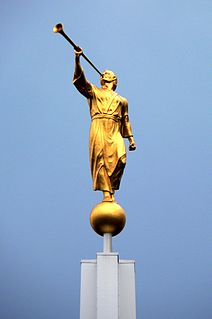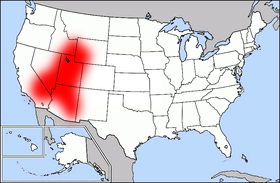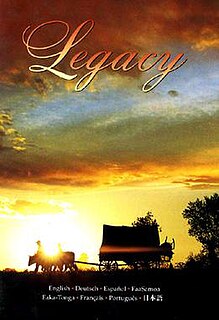
The Book of Mormon is a sacred text of the Latter Day Saint movement, which, according to Latter Day Saint theology, contains writings of ancient prophets who lived on the American continent from approximately 2200 BC to AD 421. It was first published in March 1830 by Joseph Smith as The Book of Mormon: An Account Written by the Hand of Mormon upon Plates Taken from the Plates of Nephi. The Book of Mormon is the earliest of the unique writings of the Latter Day Saint movement, the denominations of which typically regard the text primarily as scripture, and secondarily as a historical record of God's dealings with the ancient inhabitants of the Americas. The archaeological, historical, and scientific communities do not accept the Book of Mormon as an ancient record of actual historical events.

The Angel Moroni is an angel whom Joseph Smith reported as having visited him on numerous occasions, beginning on September 21, 1823. According to Smith, the angel was the guardian of the golden plates, buried in the hill Cumorah near Smith's home in western New York; Latter Day Saints believe the plates were the source material for the Book of Mormon. An important figure in the theology of the Latter Day Saint movement, Moroni is featured prominently in Mormon architecture and art. Besides Smith, the Three Witnesses and several other witnesses also reported that they saw Moroni in visions in 1829.
Stephen Edward Robinson was a religious scholar and apologist, who was a member of The Church of Jesus Christ of Latter-day Saints.
The Lamanites are one of the four ancient peoples described as having settled in the ancient Americas in the Book of Mormon, a sacred text of the Latter Day Saint movement. The Lamanites also play a role in the prophecies and revelations of the Doctrine and Covenants, another sacred text in the Latter Day Saint movement.

According to the Book of Mormon, the Anti-Nephi-Lehies were an ethnic group of Lamanites formed around 90 BC, after a significant religious conversion. They made a covenant that they would not participate in war, and buried their weapons. Eventually they changed their name to The People of Ammon, or Ammonites. During a later period of warfare, the young men of the group who had not made the pacifist covenant became a military unit known as the Two Thousand Stripling Warriors, and were protected by divine intervention.

The Mormon Corridor is the areas of Western North America that were settled between 1850 and approximately 1890 by members of The Church of Jesus Christ of Latter-day Saints, who are commonly nicknamed “Mormons”.

Legacy: A Mormon Journey is a 53-minute film produced by The Church of Jesus Christ of Latter-day Saints. Legacy depicts the life of two recent converts from the 1830s to the 1890s. The characters are fictional, though the events they experience are historical.

Mr. Krueger's Christmas is a 1980 American Christmas short television film produced by The Church of Jesus Christ of Latter-day Saints, starring James Stewart, directed by Kieth Merrill, with story by Michael H. McLean, and featuring the Mormon Tabernacle Choir. It was first broadcast on NBC on December 21, 1980.
Mormons have both used and been subjected to significant violence throughout much of the religion's history. In the early history of the United States, violence was used as a form of control. Many people of different faiths used violence in order to harass and persecute people who adhered to different religious beliefs. Mormons were violently persecuted and pushed from Ohio to Missouri, from Missouri to Illinois and from Illinois, they were pushed west to the Utah Territory. There were incidents of massacre, home burning and pillaging, followed by the death of their prophet, Joseph Smith. Smith died from multiple gunshot wounds in a gun battle while jailed in Carthage; Smith defended himself with a small pistol smuggled to him by Cyrus Wheelock while trying to protect himself against an illegal mob. There were also notable incidents in which Mormons perpetrated violence. Under the direction of Mormon prophets and apostles, the Mormon burned and looted Davies County, attacked and killed members of the Missouri state militia, and carried out an extermination order on the Timpanogos. Other Mormon leaders led the Mountain Meadows Massacre, Battle Creek massacre, and Circleville Massacre. Mormons have also been a major part in several wars, including the 1838 Mormon War, Walker War and Black Hawk War.

Christian Nephi Anderson was a prominent Utah novelist and member of The Church of Jesus Christ of Latter-day Saints. A prolific writer of the "Home Literature" period of LDS fiction, Anderson published ten novels including the bestselling Added Upon (1898), as well as short stories, poetry, essays, and a history of the Church for young people.
Sidney Branton Sperry was one of three scholars who were members of The Church of Jesus Christ of Latter-day Saints who began the scholarly and systematic study of the Book of Mormon in the mid-20th century — the other two being John L. Sorenson and Hugh W. Nibley. Sperry was also a leading Latter-day Saint scholar of the Bible.
John Sears Tanner is a former president of Brigham Young University-Hawaii (BYU-Hawaii). He was the 10th president of BYU-Hawaii, serving from 2015 to 2020. He previously served as first counselor in the General Sunday School Presidency of The Church of Jesus Christ of Latter-day Saints, as president of the church's Brazil São Paulo South Mission and as Academic Vice President of Brigham Young University (BYU). Tanner is married to Susan W. Tanner, a former general president of the LDS Church's Young Women organization.

The tree of life vision is a vision discussed in the Book of Mormon, one of the scriptures of Latter Day Saint movement, published by Joseph Smith in 1830. In the Book of Mormon, the vision was received in a dream by the prophet Lehi, and later in vision by his son Nephi, who wrote about it in the First Book of Nephi. The vision includes a path leading to a tree symbolizing salvation, with an iron rod along the path whereby followers of Jesus may hold to the rod and avoid wandering off the path into pits or waters symbolizing the ways of sin. The vision also includes a large building wherein the wicked look down at the righteous and mock them.

One Hundred Years of Mormonism is a 1913 film depicting the early history of The Church of Jesus Christ of Latter-day Saints. The six-reel film took its title from the 1905 book by Mormon educator John Henry Evans. Ellaye Motion Picture Company was originally contracted by the church's leadership to produce the film, but the company broke its contract and was replaced by the Utah Moving Picture Company, with prominent screenwriter Nell Shipman completing the screenplay for a then-unprecedented fee of $2,500. Filming took place on locations across California and Utah. The filming locations in Utah were Salt Lake City, Daniel's Pass, and Heber.

Joseph L. Heywood was a local leader of The Church of Jesus Christ of Latter-day Saints in the 19th century, and the founder of Nephi, Utah.
The Mountain of the Lord is a 72-minute film produced by The Church of Jesus Christ of Latter-day Saints. It depicts the story of the building of the Salt Lake Temple in a fictional encounter between a reporter and Wilford Woodruff and was produced for the centennial of its dedication. The film shows the struggles of early Mormons to build the temple—which took 40 years to complete—in the Salt Lake Valley, where church members arrived in 1847.

The following outline is provided as an overview of and a topical guide to The Church of Jesus Christ of Latter-day Saints.

The following outline is provided as an overview of and topical guide to the Book of Mormon:










